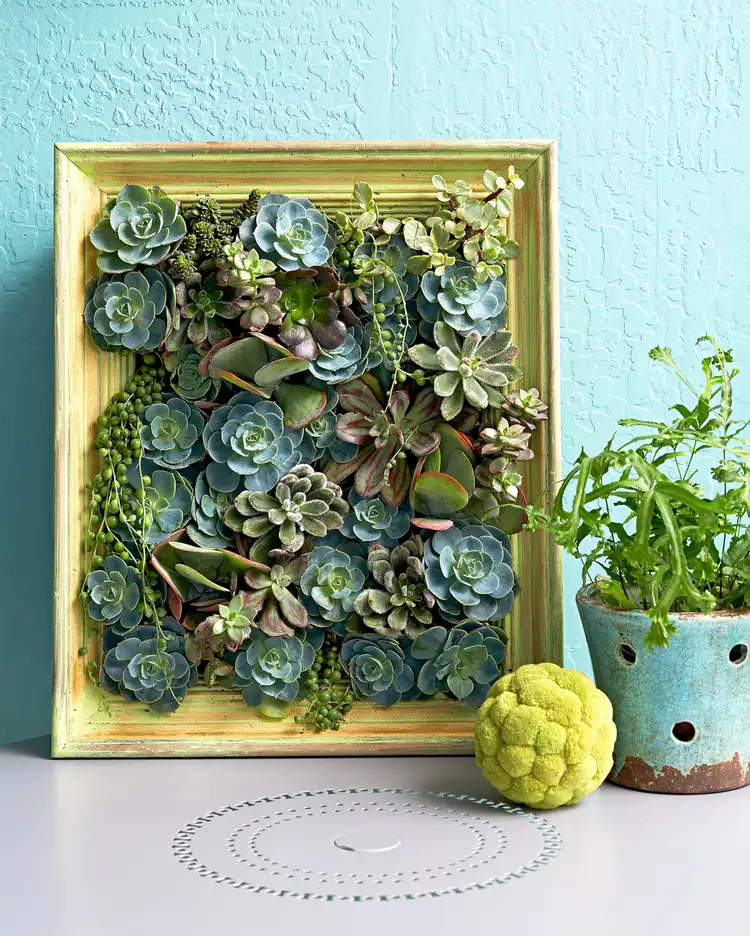- Working Time: 3 hours
- Total Time: 4 hours
- Skill Level: Intermediate
- Estimated Cost: $25 to $40
- Yield: Framed succulent wall art
Add a little charm and greenery to your home with beautiful succulent wall art using plants and an old picture frame. Succulents are a natural choice for vertical gardens since they grow slowly and require little water. As a bonus, they come in so many shapes and colors that it's easy to create a unique design. Use this step-by-step guide to make living succulent wall art.
What You'll Need
Equipment / Tools
- Small pruning snips
- Saw
- Hammer
- Staple gun
- Paint brush
- Clean cloth
- Chopstick or pencil
Materials
- Succulent cuttings
- Shadow box made of redwood or cedar 1x3s, cut to fit the back of the frame
- Picture frame with back and glass panel removed
- Nails
- 1/2-inch hardware cloth, cut to fit the inside dimensions of the frame
- Staples
- 1/4-inch plywood backing, cut to fit the back of the shadow box
- Paint
- All-purpose potting soil
Instructions
How to Make Succulent Wall Art
-
Make the Cuttings
Taking cuttings from established succulents growing in your home or garden is easy. With small pruning snips, cut stem sections one to two inches long. Remove the lower leaves. Roots will sprout from these leaf nodes. Let the cuttings dry on a tray for a few days before you plant them. This curing process causes cut ends to callus (form a thin layer of cells).
-
Cut the Shadow Box Frame
A shadow box adds depth to the back of the picture frame, allowing space for soil and plant roots. Cut naturally water-resistant redwood or cedar 1x3s to fit the back of the frame. Nail or screw into place.
-
Set the Hardware Cloth
With the frame still face down, insert the hardware cloth. The 1/2-inch grid is small enough to hold in potting soil yet large enough to accommodate stems. Staple the hardware cloth to the edges of the frame.
-
Add Backing
After setting the hardware cloth, lay 1/4-inch plywood backing on the back of the shadow box and secure it with nails. This backing will be the finishing touch to your shadow-box frame.
-
Paint the Frame
Turn the frame face up. Brush on a coat of outdoor paint, offering protection against the elements. For an antique effect, let the paint dry for a few minutes and then wipe the frame with a clean cloth. If desired, paint the underlying box, too.
-
Add Soil
Allow the frame to dry completely before filling the box with potting soil. Pour soil on top of the hardware cloth, using your hands to push it through the openings. Shake the frame periodically to evenly disperse the soil. Add more soil until it reaches the bottom of the wire grid.
-
![Step 8: Poke a Hole]()
![poke holes]()
PHOTO: Peter Krumhardt Poke Holes
On a flat surface, lay out your succulent cuttings in the frame according to the design you want. Push a chopstick or pencil through one square of the wire grid into the soil. This will create a hole to place the succulent and allow it to root.
-
![Step 9: Fill In with Plants]()
![fill plants]()
PHOTO: Peter Krumhardt Fill with Plants
Place the stem of a succulent cutting, such as this mother of pearl plant (Graptopetalum paraguayense), into the planting hole. Be sure to allow the leaf rosette to rest on top of the wire grid. It's unnecessary to dip cuttings in rooting hormone since succulents root easily in soil, but it can help speed the process.
-
Create the Design
Tuck in the larger plants first, then plant the rest as closely as the grid allows. Depending on plant size, not every square will be planted. Right after you've planted, you may see hints of the wire, but as the succulent wall art plants grow, they'll close the gaps.
-
Let It Root
After you've planted your design, keep the succulent wall art flat and out of direct sunlight for a week or two to allow the stems to form roots. For additional security, support the stems with floral pins or crafts clips. Then, gradually increase the light levels to total sun exposure. Don't water the first two weeks.
-
Put it on Display
Set the succulent wall art on a table or shelf where it can be propped against a wall, or hang it on a wall using sturdy picture hooks. Water succulents once a month. Lay the frame on a flat surface and thoroughly moisten the soil. Don't hang it again before the frame is dry. In hot areas, protect the plants from midday sun. Indoors, set succulent wall art near a south-facing window.
Create More Artwork for Your Home
Artwork is the jewelry for any home design ensemble, but it can be hard to find exactly what you want, and it can be pricey. Make your own creations for a personal touch that's budget-friendly.
A DIY watercolor is a pretty and simple project, and you can choose the colors to match your decor. If you're a thrift shop fan, we have 21 projects you can do with your found objects. Abstracts are a great fit for a contemporary space, and no one will guess your piece is a DIY project. If your home has a boho aesthetic, make a macrame planter to add greenery with a vintage vibe. DIY art is a wonderful way to make your home reflect your style.

:strip_icc():focal(274x0:276x2):format(webp)/101671221-23680debcfd54f59bb8c629c7e0f7592.jpg)
:strip_icc():focal(533x969:535x971):format(webp)/poke-holes-d5ca7457-4abd098217e349c3adb31e22e392c266.jpg)
:strip_icc():focal(274x0:276x2):format(webp)/101671222-4ba1799649054dc1a4dede3234ed78fa.jpg)
:strip_icc():focal(608x876:610x878):format(webp)/fill-plants-7ec0510f-a1bc017c01034950bf432f1947c944aa.jpg)



















